Blog
"Tailgating" as a security breach, part III
by Paul Kazlauskas

In 2015, fellow Threshold Blogger Andy Jones posted a two-part story about “Tailgating” as a security breach. Andy defined “tailgating” (AKA piggybacking), explained why it’s a problem, and outlined 10 ways to prevent it (see links to his previous parts at the end of this post).
Today, I will expand on the physical security tools (AKA anti-tailgating devices) that facilities can implement to solve the problem. Choosing the right anti-tailgating device requires the consideration of a number of variables, including the overall desired level of security, whether or not security guards will monitor the tool, and your budget for initial purchase and ongoing maintenance. The approximate costs, as well as the pros and cons, will be discussed in this piece.
Half-Height Mechanical Turnstile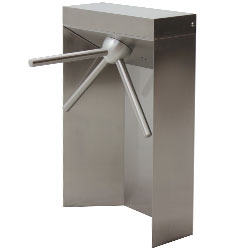
This security tool is composed of rotating mechanical barrier arms installed at waist height to prevent passage through a doorway. Using a valid access control card causes arms to unlock, allowing passage of one person, because the system is electronically controlled.
Approximate cost: $3,000 to $5,000
Pros: Very affordable option, commonly used, dependable, doesn’t take up a lot of space.
Cons: Handicapped users can’t operate it, rotating arms can be climbed over or under, tends to be noisy.
----------------------------------------------------
Full-Height Mechanical Turnstile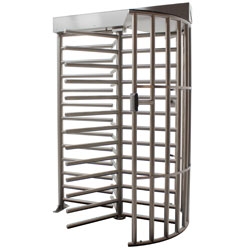
This anti-tailgating security tool has rotating mechanical barrier arms installed to prevent passage through it’s opening. The device extends from the floor to a height of approximately eight feet. Much like the Half-Height version above, a valid access control card causes arms to unlock, allowing the passage of one person.
Approximate cost: $5,000 to $8,000
Pros: Very good security at a middle-range cost, reliable.
Cons: Handicapped users can’t operate it , very large, wouldn’t fit some locations, tends to be noisy when used.
----------------------------------------------------
Doorway Anti-Tailgating Device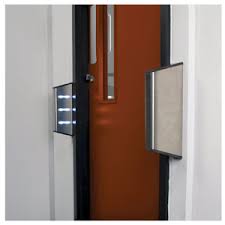
This tool consists of two small devices installed on each side of an entranceway. The two devices are equipped with electronic sensor beams that transmit between them. When a person passes through the door, there is an interruption in the sensor beam and an alarm sounds unless a valid access control card has first been used. Sensor beams are connected to a computer processor that detects when more than one person attempts to pass though the opening on a single card scan.
Approximate cost: $5,000 to $7,000
Pros: Easy add-on to existing doors, provides protection against tailgating, unobtrusive in appearance, accommodates handicapped users, less expensive than Optical Turnstiles.
Cons: Must be used at an entrance manned by security guard because it can be ducked under, does not provide good visual and audible cues to users, some false alarms.
----------------------------------------------------
Optical Turnstile
This security tool consists of two pillars that are positioned on each side of an entranceway. The two pillars have electronic sensor beams that transmit between them. When a person walks between the pillars, an alarm will sound if they have not used their access control card as they approached the device. Sensor beams are connected to an operating system that detects when more than one person attempts to pass on a single card scan.
Approximate cost: $15,000 to $20,000
Pros: High-tech device, accurate, reliable, accommodates handicapped users, excellent sound system when a breach occurs.
Cons: Expensive, no physical deterrent (someone can just run through), can only be effectively used when a security guard is present, some training is required to use it correctly.
---------------------------------------------------
Security Revolving Door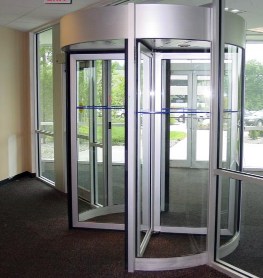
A security upgrade on the typical revolving door. The unit extends from the floor to a height of approximately eight feet. Typically has multiple quadrants equipped with electronic sensors that detect the number of people in each quadrant. Use of a valid access card allows one person to pass through the door. If more than one person attempts to enter, the door sounds an alarm and locks to prevent entry.
Approximate cost: $35,000 to $50,000
Pros: Provides the best protection against tailgating and piggybacking, doesn’t cause backups of people entering the facility, unassuming in appearance.
Cons: Expensive, handicapped users can’t operate it, regular maintenance is required.
-----------------------------------------------------
Thank you for taking the time to read Part III of this story. To read the previous parts to this story, please see the links below…
“Tailgating” as a security breach, part I
“Tailgating” as a security breach, part II
How does your organization prevent tailgating and piggybacking? Please tell us in the
Our visitor badges “VOID” overnight to prevent reuse. 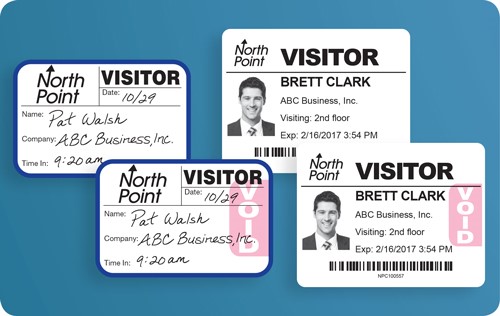
See them for yourself — request free samples!
Posted on 4/22/2016



 Paul Kazlauskas
Paul Kazlauskas
 Andrew Jones
Andrew Jones